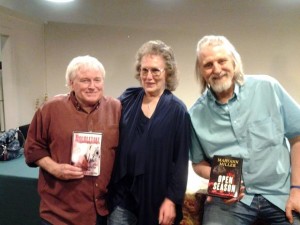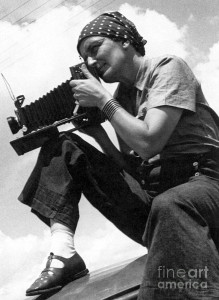This past weekend was not nearly as busy as the previous one. On Friday night I went to the concert at the Winnsboro Center For the Arts and heard Trout Fishing in America. If you have never heard this duo of Ezra Idlet and Keith Grimwood perform, you should try to catch a concert the next time they’re in your area. They are talented singers, musicians, and funny, funny guys. Meeting them was like connecting with old friends, and I loved the music and the visits. I was thrilled to find out the Keith is an avid mystery reader – and we like some of the same authors – and he bought two of my books.

Then on Saturday night I went to a painting party with my daughter, Dany, taught by Brenda Roberts, the art director at the Winnsboro Center for the Arts and owner of Sayadream Studio. I’ve dabbled in painting before and find it very therapeutic, so I wonder why I don’t do this more often.

CELEBRATING STRONG WOMEN Dorethea Lange – Photographer
Dorothea Lange (May 26, 1895 – October 11, 1965) was an influential American documentary photographer and photojournalist, best known for her Depression-era work for the Farm Security Administration (FSA). Lange’s photographs humanized the consequences of the Great Depression and influenced the development of documentary photography.
Lange grew up in New Jersey and later attended Columbia University in New York City, studying photography under Clarence H. White. She had apprenticeships in several studios in New York, before leaving and eventually settling in San Francisco to work as a photo finisher. The following year she opened a successful portrait studio and lived in Berkeley for the rest of her life. In 1920, she married the noted western painter Maynard Dixon, with whom she had two sons, Daniel, born in 1925, and John, born in 1930.
During the Great Depression, Lange took her camera to the streets, where she photographed the many unemployed and homeless people. One of her most famous photos was “White Angel Breadline.” The focal point was a man turned away from the crowd in front of a soup kitchen, and the attention the photo garnered led to her employment with the federal Resettlement Administration (RA), later called the Farm Security Administration (FSA).

In December 1935, she divorced Dixon and married economist Paul Schuster Taylor, Professor of Economics at the University of California, Berkeley. With him, Lange spent the next five years documenting rural poverty, especially the exploitation of sharecroppers and migrant laborers. Taylor would interview workers and gather economic data, while Lange captured the images of poverty. She freely shared her images free with newspapers across the United States, and her work brought the plight of the poor and forgotten to public attention.
Lange’s best-known picture is titled “Migrant Mother.”[7] The woman in the photo is Florence Owens Thompson.
In 1960, Lange spoke about her experience taking the photograph:
I saw and approached the hungry and desperate mother, as if drawn by a magnet. I do not remember how I explained my presence or my camera to her, but I do remember she asked me no questions. I made five exposures, working closer and closer from the same direction. I did not ask her name or her history. She told me her age, that she was thirty-two. She said that they had been living on frozen vegetables from the surrounding fields, and birds that the children killed. She had just sold the tires from her car to buy food. There she sat in that lean-to tent with her children huddled around her, and seemed to know that my pictures might help her, and so she helped me. There was a sort of equality about it.
At the time, Lange told the editor of a San Francisco newspaper about conditions at the camp and provided him with two of her photos. The editor reported the conditions to federal authorities and published an article that included the photos. As a result, the government rushed aid to the camp to prevent starvation
Twenty-two of the photographs Lange took as part of the FSA were included in John Steinbeck’s The Harvest Gypsies when it was originally published in San Francisco News in 1936. In 1941, Lange was awarded a Guggenheim Fellowship for achievement in photography. After the attack on Pearl Harbor, she gave up the prestigious award to record the forced evacuation of Japanese Americans from the West Coast, on assignment for the War Relocation Authority (WRA).
In 1972 the Whitney Museum used 27 of Lange’s photographs in an exhibit entitled Executive Order 9066. This exhibit highlighted the Japanese Internment during World War II.
On December 15, 2008, Lange was inducted into the California Hall of Fame, located at The California Museum for History, Women and the Arts. Her son accepted the honor in her place.
In 2014, American Masters – “Dorothea Lange: Grab a Hunk of Lightning” premiered August 29 on PBS. The documentary was directed and narrated by Lange’s granddaughter, Dyanna Taylor, who is a five-time Emmy award-winning cinematographer. Dorothea Lange: Grab a Hunk of Lightning, by Elizabeth Partridge, was published in 2013 and is the only career-spanning monograph of Lange’s work in print.
So today I salute Dorothea Lange for her art and her heart.
